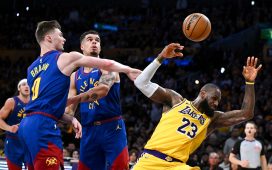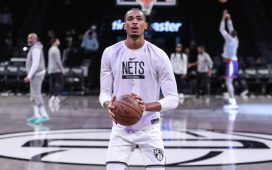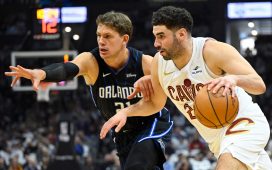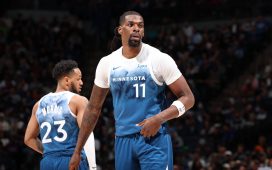Around the NBA, executives are either in or out on RJ Barrett moving forward.
Barrett is one of those players who tends to evoke strong emotions league-wide, with few having a down-the-middle take on what his future holds. Over the years, I’ve had so many conversations about him with NBA general manager levels to front-office members to NBA pro personnel scouts to scouts on the college side that I’ve lost count. And the takeaway is simple: He is polarizing, and evaluators feel that way for reasons in Barrett’s control, and outside of it.
From a simple evaluation perspective, some scouts believe in the shooting improvements he’s made, while others don’t seem to buy his touch and ability to be consistent long term. Some people in league circles will point to his aggressiveness and physicality as a driver as a reason to buy him long term, while others worry about the fact that he’s more of a below-the-rim athlete and don’t love his touch at the basket. Some love his ability to get downhill, but others question what happens from a decision-making perspective in terms of his shot selection and passing once he gets that head of steam. From a value perspective, some see him as a future All-Star; others are less sold and think he’s probably just a starter.
Even that is reductive regarding the context, though. Barrett just turned 22 years old, but he’s been in the public eye for years. That can’t be underestimated as a big reason everyone around the league seems to have such a set-in-stone idea of what he is. Headlines had him “conquering the world” and saw him as a potential No. 1 overall pick by the time he was 17. And he had the accolades to back it up. He won the Jordan Brand Classic International game MVP at 15 years old. He won MVP of the under-19 World Cup at 17 years old, leading Canada to a gold medal and its best-ever finish in a FIBA-sanctioned tournament after a dominant 38-point, 13-rebound performance against a United States team loaded with eight future NBA rotation players. He was tagged with the moniker “Maple Mamba” as a nod to his Canadian heritage, his laser focus and his scoring prowess that was evocative of Kobe Bryant from a young age.
But all of this also led to a large amount of scrutiny from NBA scouts very early. While someone such as Oklahoma City Thunder lottery pick Jalen Williams truly emerged onto NBA radars as a 20-year-old this past season after a full high school career and amid his third full season in college, NBA teams had compiled in-depth scouting reports on Barrett two years before he reached college. While Barrett is just 10 months older than Williams, teams genuinely have five more years of scouting reports and maybe a couple hundred more games worth of data points on Barrett than they do on Williams. Such is the reality for players who are successful in their mid-teens and who reach the NBA in their late teens. Is it unfair to be so scrutinized that early in your development? Probably. But it’s the hand you’re dealt when you showcase elite talent so early.
More than all of that, though, the real context for front-office evaluators is that they have understood for a while that a large contract was coming for Barrett in some capacity. Wings who are 6-foot-6, go No. 3 overall in their draft, have this kind of pedigree and average 20 points per game in the NBA by the time they’re 21 years old tend to get paid. It’s not just the question of, “Is he good?” The question morphs into, “Is he a guy you should be willing to commit a nine-figure financial investment in?” This is why sources around the league have had differing opinions as to whether the Utah Jazz would (or even should) try to prioritize Barrett in a potential Donovan Mitchell trade with the Knicks. Would they want to acquire Barrett knowing he was on the verge of getting paid? Or would they decide to bet on other young Knicks players who are further away from their second contract? Is Danny Ainge an RJ Barrett believer or not?
The Knicks didn’t quite take that decision out of the Jazz’s hands this week, but at the very least, they substantially limited the number of pathways for the Jazz to acquire Barrett and decided to make the plunge on that investment into his future themselves. New York agreed to a four-year, $107 million rookie extension with an incentive structure involved that could see it rise to $120 million, per The Athletic’s Shams Charania. It’s possible the Jazz could still acquire Barrett, but they’d be subject to the poison-pill provision attached to every player who is extended, where Barrett’s outgoing salary for the Knicks in a trade would be $10.9 million, but his incoming salary for the Jazz would be in the ballpark of $23.6 million (depending on the incentive structure of the deal). This is why we so rarely see players traded following an extension agreement. The mechanics get very difficult and typically require a third or even fourth team to get involved.
In terms of the agreement itself, the contract looks big on its face right now, but basically every single contract signed over the next 18 months needs to be taken with a massive grain of salt. With the way the league is projecting the salary cap to rise because of the influx of further revenue (be it from television/streaming deals or further inroads internationally into newer markets), it’s pretty difficult for a team to sign a bad extension without max language as long as the deal starts in 2023-24 or later (as Barrett’s will). Agents around the league obviously are aware of this and are negotiating as such.
But Barrett was always in an advantageous position to get paid because it’s very easy to make strong arguments in favor of his play so far. According to Basketball-Reference.com, since 2000, only nine other players have averaged 20 points, five rebounds and three assists per game in a season by the time they were 21 years old. Eight of those players went on to make an All-Star team. Still, you might argue those aren’t Barrett’s comparable players. Rather, I found a group of players who averaged somewhere between 15 and 21 points per game, at least five rebounds, over 2.5 assists and under a 54.0 true-shooting percentage by the time they were 21 years old. Barrett has actually done this twice, so it gives us a nice window into what he actually is while removing a couple of outliers (like Luka Dončić and Tracy McGrady). Ten players are reasonable statistical comps to Barrett in that regard. Five of those guys (LeBron James, Carmelo Anthony, Elton Brand, LaMelo Ball and Brandon Ingram) went on to be All-Stars, and I’d bet on another — Cade Cunningham — to hit that level at some point. The common denominator between all of those players? All were top-three draft picks who had a lot of usage placed on their shoulders early while playing for bad teams. Two of the others are Josh Smith and Lamar Odom — two strong players on winning teams — and the final two are Tyreke Evans and Cole Anthony. Again, with Odom and Evans, you see top-four picks who were responsible for a lot.
This is what happens with young players who probably aren’t quite ready to help a team win or be efficient when they’re handed high-level usage early. They’re asked to do a lot, they struggle with efficiency, and then they tend to get older and figure it out. Being able to take on that much of a workload and become that productive at that age is a fairly good barometer of high-level success in the NBA at some point. This is far from a universal truth, but it’s more likely than not. Evans is really the only guy who was as productive as Barrett who wasn’t all that successful as an NBA player on good teams. That’s why some team was always going to bet on Barrett and pay him. His intersection of production and efficiency hasn’t quite been good enough yet. But the signs are positive.
As you could probably guess, I’ve long been on the side of believing in Barrett. I think we’ve seen real, tangible improvements in his game over the last few years that should make you buy into him becoming something in the ballpark of a top-35 player in the league — with a real chance at being an All-Star reserve at his peak. And while some were concerned after what they saw this past season, I think context is important.
Barrett really struggled early in his third season, leading some to believe he’d regressed a bit following a strong sophomore campaign when he helped the Knicks secure a top-four seed in the Eastern Conference as their second-leading scorer and a solid team defender. His first nine games were strong, but he went into a bit of a shooting funk in November. In December, he got a bad stomach bug that knocked him out for a couple of days, followed by a COVID-19 infection about a week later that stopped him from playing or even working out for 10 days. He was sluggish for the rest of the calendar year of 2021 as he worked himself back into shape. Overall, in his first 33 games, Barrett averaged about 15 points, five rebounds and two assists while his efficiency suffered.
After he recovered by the start of the 2022 portion of the season, though, Barrett went on a tear. He averaged 24 points, six rebounds and nearly four assists per game, he shot 35 percent from 3 on over six attempts per game, and he got to the line 7.5 times per game. It was the exact leap that was expected of him in the preseason. But because the Knicks were a disappointing 17-19 when the calendar turned over — and because there were other important developments such as Julius Randle’s regression — it went a bit more unnoticed than you’d think a clear breakout for a 21-year-old would.
Moreover, there were substantial stylistic changes from Barrett in the back half of last season. As The Athletic’s Fred Katz noted in a deep dive on Barrett in March, he made a mindset adjustment at that time. Long an aggressive driver toward the basket, we saw Barrett get even more assertive at attacking the rim. It was a lot of catch-and-shoot 3s, or it was an aggressive slash to the rim. From Jan. 1 onward, Barrett averaged 16.1 drives per game. He took 8.6 shots per game off those drives, the seventh-most in the NBA over that time.
The Knicks love to start Barrett in the right corner and get him the ball flying up the wing off dribble-handoffs. If he can get downhill immediately off those actions going to his dominant left hand, that’s the goal. But I think Barrett got better this past season at navigating screeners and defenders and finding clearer pathways toward the basket by pausing, playing more often with his right hand before trying to get back to the left. Here’s an example where he takes such a dribble-handoff, waits for the screen reversal from Jericho Sims, then attacks. But instead of just trying to get downhill immediately like he would earlier in his career, Barrett uses a hesitation step, crosses over to get back to his left, then waits for Sims to get in position to seal off Hassan Whiteside as a rim protector with a little interior screen.
Getting those wide-open looks at the basket is a key development. Barrett’s never been the shiftiest guy through his hips, but he’s strong and gets to the rim quickly. Patience is going to be the key for him as a finisher because he doesn’t always separate as much as you’d love to see. Still, he’s getting better with that poise in the paint. And that’s really going to be a swing skill because part of the issue most evaluators have with Barrett is that he is an excessively poor finisher at the basket right now. If anyone gets a clean look at contesting him, it’s trouble. That’s why the touch question for scouts is real. Barrett made just 43.5 percent of his looks at the rim this past season. Among the 209 players to take at least 100 attempts at the basket, he finished 205th.
Barrett isn’t an awesome vertical athlete and has to rely a lot on his ability to finish below the rim. Part of it is that he ends up taking a lot of contested looks, but he also will blow more open ones than you’d like to see. And his lack of right hand is pretty troubling. He can handle with his right hand now — a marked improvement — but he’s not comfortable rising up to finish with it. Below is an example against Brooklyn in March. Barrett does a great job of getting a half-step on Nets’ center Nic Claxton, and he has an open lane to the right side to finish with his right hand. But instead, he tries to finish with his inside left hand despite Claxton being glued to his left hip and immediately ready to contest on that side.
If his momentum gets cut off or stopped when he’s driving to the right, he’s almost always going to try to pivot back and finish with a little lefty floating shot that was not very successful last season. At times, he can get a bit of tunnel vision on his drives. Instead of reading what the defense gives him, he’ll often premeditate his decision before he starts his drive. That’s where the decision-making and efficiency questions come into play. It’s not with turnovers; it’s with shot selection. Like a lot of young players, Barrett hasn’t quite mastered kickout reads yet, and if he’s going to pass, he is a bit better at looking inward and throwing lobs or dump-offs than he is at using his vision and looking outward.
Below a late-game example against Memphis, where Desmond Bane cuts him off on a drive to the right. Instead of trying to hit the kickout, Barrett tries to throw up that little pivot floater with his left with one of the best defensive players in the NBA, Jaren Jackson Jr., waiting. In a couple of years, I’d bet this is a kickout to the wide-open Immanuel Quickley for 3.
There are contextual factors here too. On the surface, the Knicks 3-point shooting numbers look solid. They hit almost 36 percent last season on an above-average volume. The problem is that lineups with Barrett tended to not have a ton of floor spacing because of who he was playing with. Mitchell Robinson basically has zero gravity, and his man stays at the basket almost all the time. Sims and Nerlens Noel are similarly non-shooters. Randle regressed to the mean last year as a shooter, and Barrett played almost three-quarters of his minutes with Randle on the court. Basically, the Knicks’ bigs got zero respect last year as shooters, and it resulted in bodies almost always being in the paint. Bigs were very comfortable flying off the Knicks’ bigs and contesting Barrett. He had to adjust to become more slithery, or he had to just start barreling himself into the opposing bigs’ bodies and hope for a foul. He improved at the former, but the latter was much more common in the back half of the season. It was relatively successful, as he got to the line often. But it’s hard to make a living that way, and Barrett will need to make a leap as a free-throw shooter to take true advantage of it. He has hovered around the 70 percent mark throughout his career from the line.
He might fluctuate a bit month-to-month, but in his prime, I buy that Barrett is going to make somewhere between 36 to 39 percent of his 3s over a full season. But for someone as attack-oriented as he is, he has to take a leap in his ability to consistently make shots at and around the rim. And getting rid of some of the low-percentage shots at the rim and turning those into assists will be a huge boon to his efficiency. Barrett isn’t a selfish player. He wants to make the right play. He’s also a good defender already, playing well within a team concept and using his strength to be a competitor on the perimeter.
So given those concerns, why am I buying into Barrett? First and foremost, it’s hard to create this many shots at the rim. Barrett can do that, and as I said above, I buy the shooting. But more than anything, Barrett is known throughout the NBA as a guy who is willing to put in the time. He wants to be great. Everyone who speaks publicly about Barrett raves about this aspect of his game. Knicks coach Tom Thibodeau has typically been very positive about Barrett as a worker. Randle talks about it, and sources around the league will privately tell you the same. Barrett really pushes himself, and I think his issues are fixable. Continuing to slow down and being more patient is something that comes with experience. Decision-making on drives comes with getting reps and watching tape. Getting more confidence and skill finishing with your right hand is workable. He has already made strides as a shooter. If I were Utah and I were rebuilding with a Mitchell trade and had a clean cap sheet forthcoming after I make follow-up trades of my veterans, this is the kind of guy I would prioritize acquiring.
But this is also undeniably a projection. In the end, every team and evaluator is going to value each piece of information differently and could reasonably come to a different conclusion. Heck, my colleague Seth Partnow certainly comes to his own and starts an online firefight of discourse for Knicks fans every year because of where he places Barrett within his NBA Player Tiers. But again, Seth is not alone in that take. There are people in front offices who feel similarly.
Still, Barrett is maybe the prime example league-wide of how scouting and team-building is an inexact science. NBA teams might have more information on Barrett than they do on any other 22-year-old on planet Earth because of how quickly he emerged into being an elite prospect. We’re now working with almost seven years of intel and almost 7,000 NBA minutes. You’d think that each team has all of the information it needs. And yet all of that information still results in having to gamble a bit because, at the end of the day, we’re talking about drafting teenagers and having to make large-scale, nine-figure financial decisions about 22-year-olds. Players who are 22 years old are still so young in the grand scheme of the NBA.
Team-building in the NBA is exceptionally difficult, and I’m not sure there is a better encapsulation of that than all of the decisions surrounding Barrett right now — from one team’s impending decision on whether to prioritize him in a trade to another’s decision to invest significant financial resources in him.
Related reading
Prada: Barrett’s extension ends one of the most absurd streaks in sports
Jones: Barrett deal throws wrench into Mitchell trade talks
(Top photo: Tom Horak / USA Today)









